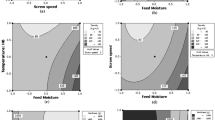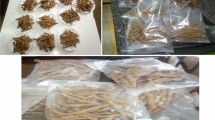Abstract
To establish the effect of barrel temperature, screw speed, total moisture and fish flour content on the expansion ratio and bulk density of the fish based extrudates, response surface methodology was adopted in this study. The experiments were optimized using five-levels, four factors central composite design. Analysis of Variance was carried to study the effects of main factors and interaction effects of various factors and regression analysis was carried out to explain the variability. The fitting was done to a second order model with the coded variables for each response. The response surface plots were developed as a function of two independent variables while keeping the other two independent variables at optimal values. Based on the ANOVA, the fitted model confirmed the model fitness for both the dependent variables. Organoleptically highest score was obtained with the combination of temperature—1100 C, screw speed—480 rpm, moisture—18 % and fish flour—20 %.


Similar content being viewed by others
References
Ali Y, Hanna MA, Chinnaswamy R (1996) Expansion characteristics of extruded corn grits. Lebensm Wiss Technol 29:702–707
Altan A, McCarthy KL, Maskan M (2008) Extrusion cooking of barley flour and process parameter optimization by using response surface methodology. J Sci Food Agr 88:1648–1659
AOAC (2000) Official methods of analysis,15th edn. Association of Official Analytical Chemists. Washington DC
Asare EK, Sefa-Dedeh S, Sakyi-Dawson E, Afoakwa EO (2004) Application of response surface methodology for studying the product characteristics of extruded rice-cowpea-groundnut blends. Int J Food Sci Nutr 55:431–39
Banerjee S, Chakraborty P (1998) Physico-chemical properties of extruded aquatic feed. Ind J Fish 45:107–111
Chinnaswamy R, Hanna MA (1988) Optimum extrusion-cooking conditions for maximum expansion of corn starch. J Food Sci 53:834–840
Choudhury GS, Gautam A (2003) Effects of hydrolysed fish muscle on intermediate process variables during twin-screw extrusion of rice flour. Lebensm Wiss Technol 36:667–678
Choudhury GS, Gogoi BK (1995) Extrusion processing of fish muscle: a review. J Aquat Food Prod Tech 4(4):37–67
Choudhury GS, Gogoi BK, Oswalt AJ (1998) Twin screw extrusion of pink salmon muscle and rice flour blends: effects of kneading elements. J Aquat Food Prod Tech 7(2):69–91
Dileep AO, Shamasundar BA, Binsi PK, Howell NK (2010) Composition and quality of rice flour-fish mince based extruded products with emphasis on thermal properties of rice flour. J Tex Stud 41:190–207
Ding QB, Ainsworth P, Tucker G, Marson H (2005) The effect of extrusion conditions on the physicochemical conditions and sensory characteristics of rice-expanded snacks. J Food Eng 66:283–289
Gogoi BK, Oswalt AJ, Choudhury GS (1996) Reverse screw element (s) and feed composition effects during twin-screw extrusion of rice flour and fish muscle blends. J Food Sci 61:590–595
Guha M, Ali SZ (2006) Extrusion cooking of rice: effect of amylase content and barrel temperature on product profile. J Food Process Pres 30:706–716
Guy RCE (2001) Raw materials for extrusion cooking. In: Guy RCE (ed) Extrusion cooking technologies and applications. Woodhead Publishing Limited, Cambridge, pp 5–28
Hagenimana A, Ding X, Fang T (2006) Evaluation of rice flour modified by extrusion cooking. J Cer Sci 43:38–46
Jeyakumari A, Rathnakumar K (2006) Effect of incorporation of frozen stored minced fish on the quality of gelatinized product from rice and maize flour. Fish Technol 43(2):146–153
Kris-Etherton PM, Taylor DS, Yu-Poth S, Huth P, Moriarty K, Fishell V (2000) Polyunsaturated fatty acids in the food chain in the United States. Am J Clin Nutr 7(Suppl):179–188
Kris-Etherton PM, Harris WS, Appel LJ (2002) Fish consumption, fish oil, omega-3 fatty acids and cardiovascular disease. Circulation 106:2747–2757
Larmond E (1977) Method for sensory evaluation of food. Publ. No. 1286, Canada Dept. of Agriculture, Canada
Launay B, Lisch LM (1983) Twin-screw extrusion cooking of starches: flow behaviour of starch pastes, expansion and mechanical properties of extrudates. J Food Eng 2:259–280
Linko P, Linko YY (1981) Bioconversion processes. In: Pomeranz Y, Munck L (eds) Cereals: a renewable resource: theory and practice. American Assoc. Cereal Chem Inc, St. Paul, pp 339–494
Meng X, Threinen D, Hansen M, Driedger D (2010) Effects of extrusion conditions on system parameters and physical properties of chickpea flour-based snack. Food Res Int 43:650–658
Milan-Carrillo J, Reyes-Moreno C, Camacho-Herńandez IL, Rouzaud-Sandez O (2002) Optimisation of extrusion process to transform hardened chickpeas (Cicer arietinum L.) into a useful product. J Sci Food Agr 82:1718–1728
Myers R, Montgomery DC (2002) Response surface methodology: process and products optimization using designed experiments, 2nd edn. Wiley, New York
Nath A, Chattopadhyay PK (2007) Optimization of oven toasting for improving crispness and other quality attributes or ready to eat potato-soy snack using response surface methodology. J Food Eng 80:1282–1292
Pansawat N, Jangchud K, Jangchud A, Wuttijumnong P, Saalia RK, Eitenmiller RR, Phillips RD (2008) Effects of extrusion conditions on secondary extrusion variables and physical properties of fish, rice-based snacks. J Food Sci Technol 41:632–641
Rhee KS, Kim ES, Kim BK, Jung BM, Rhee C (2004) Extrusion of minced catfish with corn and defatted soya flours for snack foods. J Food Process Pres 28:288–301
Rolf LA, Huff HE, Hsieh F (2000) The effect of processing conditions on the quality of extruded catfish feed. Trans ASAE 43:1737–1743
Shannon DH, Robert TT (2010) Effect of protein, moisture content and barrel temperature on the physico-chemical characteristics of pea flour extrudates. Food Res Int 43:659–663
Sharma SK, Basu S (2003) Preparation of an extruded fish snack using twin screw extruder and the storage characteristics of the product. J Ind Fish Assoc 30:149–156
Shaviklo GR, Olafsdottir A, Sveinsdottir K, Thorkelsson G, Rafipour F (2011a) Quality characteristics and consumer acceptance of a high fish protein puffed corn-fish snack. J Food Sci Technol 48(6):668–676
Shaviklo GR, Thorkelsson G, Rafipour F, Sigurgisladottir S (2011b) Quality and storage stability of extruded puffed corn-fish snacks during 6-month storage at ambient temperature. J Sci Food Agr 91(5):886–893
Simopoulos AP (2000) Symposium: Role of poultry products in enriching the human diet with n-3 PUFA, human requirement for n-3 polyunsaturated fatty acids. Poultry Sci 79:961–970
Sin HN, Yusor S, Hamid NSA, Rahman RA (2006) Optimixation of enzymatic clarification of sapodilla juice using response surface methodology. J Food Eng 73:313–319
Suknark K, Lee J, Eitenmiller RR, Phillips RD (2001) Stability of tocopherols and retinyl palmitate in snack extrudates. J Food Sci 66:897–902
Thymi S, Krokida MK, Papa A, Maroulis ZB (2005) Structural properties of extruded corn starch. J Food Eng 68:519–526
Venugopal V, Shahidi F (1995) Value added products from underutilized fish species. Crit Rev Food Sci Nutr 35(5):431–453
Yuan Y, Gao Y, Mao L, Zhao J (2008) Optimisation of conditions for the preparation of b-carotene nanoemulsions using response surface methodology. Food Chem 107:1300–1306
Yuliani S, Torley PJ, D’Arcy B, Nicholson T, Bhandari B (2006) Effect of extrusion parameters on flavour retention, functional and physical properties of mixtures of starch and D-limonene encapsulated in milk protein. Int J Food Sci Technol 41:83–94
Zhou P, Regenstein JM (2004) Optimization of extraction condition for Pollock skin gelatin. J Food Sci 69:393–398
Acknowledgments
This study is part of the thesis work to obtain the degree of Master of Fisheries Science, which was developed in the Department of Fish Processing Technology of College of Fisheries, Lembucherra, Tripura, India and supported by the Central Agricultural University, Imphal, India. The authors gratefully acknowledge the staff of the department of FPT for their technical assistance.
Author information
Authors and Affiliations
Corresponding author
Rights and permissions
About this article
Cite this article
Singh, R.K.R., Majumdar, R.K. & Venkateshwarlu, G. Optimum extrusion-cooking conditions for improving physical properties of fish-cereal based snacks by response surface methodology. J Food Sci Technol 51, 1827–1836 (2014). https://doi.org/10.1007/s13197-012-0725-9
Revised:
Accepted:
Published:
Issue Date:
DOI: https://doi.org/10.1007/s13197-012-0725-9




